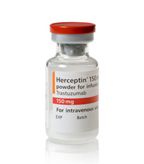PHARE: One-Year Trastuzumab Remains Standard for HER2-Positive Breast Cancer
A 6-month regimen of treatment with trastuzumab for HER2-positive breast cancer failed to show noninferiority with the standard 12-month treatment regimen after 3.5 years of follow-up in the open-label, randomized, phase III PHARE trial.
A 6-month regimen of treatment with trastuzumab for HER2-positive breast cancer failed to show noninferiority with the standard 12-month treatment regimen after 3.5 years of follow-up in the open-label, randomized, phase III PHARE trial. Despite the increased rate of cardiac events that occurred in patients assigned to 12-months of treatment, the researchers concluded that the longer regimen should remain the standard of care.

Bottle of trastuzumab; source: Roche
The optimal duration of trastuzumab has been debated since the drug was first identified as having a benefit in patients with HER2-positive breast cancer. The HERA trial recently confirmed that a 2-year regimen of trastuzumab conferred no additional benefit when compared with a 1-year regimen. The PHARE trial was designed to compare a shorter 6-month regimen to the standard 12-month regimen; results of the trial were published recently in Lancet Oncology.
The PHARE trial included women aged 18 years or older with confirmed HER2-positive breast cancer who had been treated with at least 4 cycles of prior chemotherapy and had breast-axillary surgery before randomization. The researchers enrolled patients from 156 centers in France. Patients who had undergone 6 months of trastuzumab were randomly assigned to another 6 months of treatment (n = 1,691) or to discontinuation of treatment (n = 1,693). The intention-to-treat analyses included 1,690 patients from each group.
“Commonly, a per-protocol analysis is recommended for noninferiority trials, however, an intention-to-treat analysis was chosen for our analysis,” the researchers wrote. “This choice was based on the particular design of PHARE, in which patients were scheduled to be randomized after 6 months of trastuzumab treatment to either continuation for another 6 months or to discontinue.”
After 3.5 years of follow-up, 175 disease-free survival events occurred in patients assigned to 12 months of trastuzumab compared with 219 events in the 6-month group. Data indicated that the 2-year disease-free survival was 93.8% for patients assigned the standard of care compared with 91.1% for the 6-month regimen (HR = 1.28; 95% CI, 1.01–1.56; P = .29).
A greater percentage of patients assigned to 12 months of treatment experienced cardiac events compared with patients assigned 6 months of treatment (5.7% of patients vs 1.9%; P < .0001).
The researchers also analyzed the data according to subgroups of patients. Estrogen receptor–negative patients were found to have significantly shorter disease-free survival when assigned to the 6-month regimen. No difference was found between length of treatment when the researchers looked at the results according to other combinations of trastuzumab and chemotherapy and estrogen-receptor status.
The researchers cautioned that results of the subgroup analyses should be interpreted with caution and added that “longer follow-up is needed to reach a conclusion regarding noninferiority of 6 months of treatment to 12 months of treatment with trastuzumab in any of the subgroups, since the trial was not powered to answer these questions.”